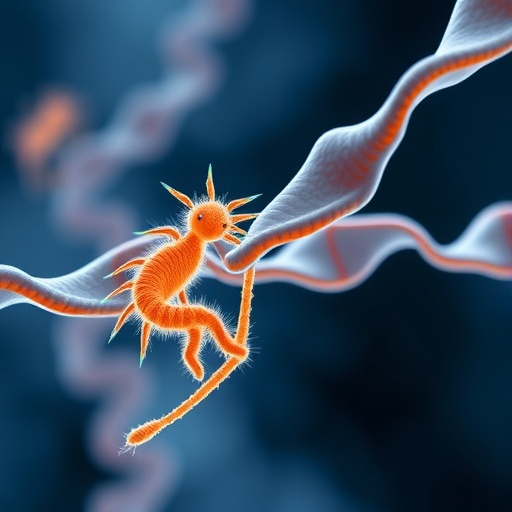
In a groundbreaking advancement poised to reshape the landscape of genetic engineering, researchers Butterfield and Gersbach have unveiled a resurrected form of an ancestral miniature Cas9 enzyme, offering unprecedented precision and versatility for genome and epigenome editing applications. This innovative approach, detailed in their forthcoming publication in Nature Biotechnology, leverages evolutionary biology to breathe new life into a compact variant of Cas9 that predates its widely used modern counterparts, potentially revolutionizing the way scientists manipulate DNA and chromatin architecture across diverse biological systems.
Cas9 enzymes, central to the CRISPR genome editing revolution, function as molecular scissors that can be guided to specific loci on the DNA to introduce targeted modifications. The most commonly deployed Cas9 protein, derived from Streptococcus pyogenes (SpCas9), has transformed molecular biology but is not without its limitations. SpCas9 is relatively large and sometimes challenging to deliver efficiently into cells, especially for therapeutic purposes where delivery vectors like adeno-associated viruses have strict size constraints. Furthermore, off-target effects and epigenetic manipulation limitations have spurred ongoing quests for more efficient, precise, and smaller Cas variants. This new research breathes new life into these inquiries by resurrecting an ancestral Cas9 enzyme that is notably miniature yet catalytically robust.
The concept of “resurrection” here refers to the computational reconstruction and laboratory synthesis of an evolutionary ancestor that likely existed millions of years ago. Using phylogenetic inference and ancestral sequence reconstruction methods, Butterfield and Gersbach identified a common ancestor within the Cas9 family that exhibits distinct structural features enabling a more compact form factor. This ancestral enzyme, while smaller, maintains the essential domains responsible for DNA binding and cleavage, circumventing compromises usually encountered in engineered Cas variants where size reduction can come at the cost of activity or specificity.
.adsslot_uoC8WcKye0{width:728px !important;height:90px !important;}
@media(max-width:1199px){ .adsslot_uoC8WcKye0{width:468px !important;height:60px !important;}
}
@media(max-width:767px){ .adsslot_uoC8WcKye0{width:320px !important;height:50px !important;}
}
ADVERTISEMENT
Extensive biochemical characterization revealed that this resurrected miniature Cas9 maintains robust nuclease activity, effectively introducing double-stranded breaks at targeted genomic loci with high fidelity. Moreover, its compactness facilitates more efficient packaging into viral vectors commonly employed in gene therapy, including the favored adeno-associated virus (AAV). The smaller size also broadens delivery options, enhancing prospects for in vivo editing strategies in tissue types previously difficult to target due to size limitations.
One of the most exciting facets of this resurrected Cas9 ancestor is its expanded utility in epigenome editing. Unlike traditional editing that merely cuts DNA, epigenome editing aims to modify DNA-associated proteins and chemistry to regulate gene expression without altering the underlying sequence. By fusing the miniature Cas9 to epigenetic effector domains, the researchers demonstrated targeted modulation of chromatin states, activating or repressing genes with remarkable spatial and temporal precision. This ability paves the way for potentially reversible and tunable therapies for diseases rooted in aberrant gene regulation, including cancers, neurological disorders, and developmental abnormalities.
Additionally, the ancestral enzyme showcased reduced immunogenicity in preliminary assays, an attribute critical for clinical applications. Modern Cas9 proteins sometimes elicit immune responses due to their bacterial origin, which can limit efficacy and safety in patients. Evolutionarily distant ancestors may present novel epitopes less likely to be recognized by the human immune system, thereby enhancing the safety profile of gene therapies employing these tools.
Structurally, high-resolution crystallography provided insights into the unique folding and active site morphology of the resurrected Cas9. Despite its small size, the enzyme preserves the quintessential bilobed architecture, integrating Recognition (REC) and Nuclease (NUC) lobes, essential for target DNA engagement and cleavage activity. Intriguingly, certain domain arrangements differ markedly from modern Cas9s, suggesting evolutionary optimizations that balance compactness with catalytic efficiency, which bioengineers could exploit in further tailoring endonucleases for specific applications.
The team also performed comprehensive genome-wide off-target analyses using state-of-the-art unbiased detection methods. Results indicated that this miniature Cas9 exhibits heightened specificity, with significantly fewer off-target cleavages compared to SpCas9 and other engineered variants. Such precision is paramount for clinical translation because unintended DNA alterations can have oncogenic or otherwise deleterious consequences. The structural determinants underpinning this specificity remain a topic for future investigation, but the initial data are promising for safer gene editing.
Beyond human therapeutics, the resurrected enzyme holds transformative potential in agricultural biotechnology. Its compactness and efficiency allow for more straightforward delivery to plant cells, where genome modifications can enhance crop resilience, productivity, and nutritional value. Furthermore, epigenetic editing capabilities might enable transient modifications that do not involve DNA sequence changes, facilitating regulatory approval and public acceptance in genetically engineered organisms.
An intriguing aspect explored by the authors involves the co-evolution of CRISPR-Cas systems and their microbial hosts. By comparing this ancestral Cas9 to homologs from extant bacteria, the research sheds light on how evolutionary pressures sculpted enzyme properties such as size, specificity, and activity to counter phage attacks effectively. This evolutionary context not only informs basic microbiology but also inspires novel engineering strategies, effectively harnessing natural diversity to overcome current technical bottlenecks.
The ability to resurrect and functionally characterize ancient biomolecules exemplifies the fusion of computational biology, synthetic biology, and structural biochemistry. It is an emblematic advance showcasing the power of interdisciplinary approaches in expanding the molecular toolbox available for precision medicine. By bridging millions of years of evolutionary history, the team has provided a new starting point for innovation beyond incremental modifications of existing proteins.
Looking forward, the researchers envisage multiple avenues to further refine and deploy their resurrected Cas9 ancestor. These include adapting the enzyme for base editing and prime editing platforms, which allow single-nucleotide changes without DNA breaks, and expanding epigenomic engineering to incorporate diverse effector domains for tailored gene expression programs. Scaling up delivery methods and refining specificity in complex in vivo systems remain high priorities as the technology edges closer to human trials.
The implications of this research resonate well beyond the laboratory. As the scientific community pushes toward realizing the promise of gene therapies for previously intractable conditions, tools that improve delivery, reduce off-target effects, and expand functional versatility become crucial. This resurrected miniature Cas9 could be the foundation of next-generation biomedical interventions, fueling treatments for genetic diseases, cancer, and beyond.
In the broader frame of genome engineering, this work exemplifies a paradigm shift from merely optimizing contemporary proteins to uncovering latent evolutionary solutions encoded in ancestral sequences. By tapping into nature’s deep molecular heritage, researchers can circumvent contemporary protein design limitations, uncover new functions, and revolutionize the scope and precision of genomic and epigenomic manipulation technologies.
In conclusion, Butterfield and Gersbach’s resurrection of a miniature Cas9 ancestor not only redefines possibilities in genome and epigenome editing but also sets a precedent for future endeavors seeking to harness evolution as a toolkit for molecular engineering. This elegant synthesis of ancient sequences and cutting-edge technology illuminates a promising path toward more efficient, safer, and versatile genome editing platforms that could transform medicine, agriculture, and fundamental biology in the coming decades.
Subject of Research: Resurrected miniature Cas9 enzyme for enhanced genome and epigenome editing.
Article Title: Resurrecting a miniature Cas9 ancestor for genome and epigenome editing.
Article References:
Butterfield, G.L., Gersbach, C.A. Resurrecting a miniature Cas9 ancestor for genome and epigenome editing. Nat Biotechnol (2025). https://doi.org/10.1038/s41587-025-02707-8
Image Credits: AI Generated
Tags: ancestral Cas9 variantButterfield and Gersbach researchcompact Cas9 applicationsCRISPR technology evolutiondelivery challenges in gene therapyepigenome editing applicationsgenetic engineering innovationsgenome editing advancementsminiature Cas9 enzymemolecular scissors in geneticsoff-target effects in CRISPRprecise DNA manipulation



